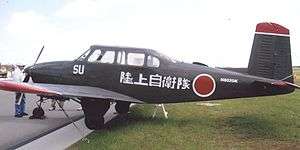Fuji LM-1 Nikko
The Fuji LM-1 Nikko is a Japanese light communications aircraft of the 1950s.
| LM-1 Nikko | |
|---|---|
 | |
| Airworthy Fuji LM-1 Nikko of 1955 in JGSDF markings at Lakeland, Florida, in April 2009 | |
| Role | military communications aircraft |
| National origin | Japan |
| Manufacturer | Fuji Heavy Industries |
| First flight | 6 June 1955 |
| Introduction | 1955 |
| Primary user | Japanese Air Self-Defense Force |
| Number built | 27 |
| Developed from | Beech T-34 Mentor |
| Variants | Fuji KM-2 RTAF-2 |
Development
Fuji Heavy Industries built 176 Beech T-34 Mentor two-seat training aircraft under licence in the early 1950s. Fuji then redesigned the basic Mentor as a four-seat communications aircraft under the designation LM-1. A new lengthened centre fuselage was added to the Mentor's wing, undercarriage and tail assembly. 27 LM-1s were produced during 1955/56.[1]
Operational history
The LM-1s were delivered to the Japanese Air Self-Defense Force (JASDF) and were used for communications and general duties.[2] After withdrawal from operation, several LM-1s were sold on the U.S. civil market and are flown by civil pilots as "warbirds".[3]
Variants
- LM-1
- four-seat communications aircraft with 225 h.p. (168 kW) Continental engine (27 built)
- LM-2
- higher-powered version with 340 h.p. (254 kW) Lycoming engine (2 built)
- LM-11 Supernikko
- A proposed more powerful version of the LM-1 powered by a 240 hp (180 kW) Lycoming GSO-480-B1A6 engine;[5] became the LM-2.
Specifications (LM-1)
Data from Green, 1956, p. 86
General characteristics
- Crew: 1
- Capacity: 3 passengers
- Length: 25 ft 11 in (7.90 m)
- Wingspan: 32 ft 9 in (9.98 m)
- Height: 9 ft 7 in (3.63 m)
- Wing area: 177.6 sq ft (16.50 m2)
- Empty weight: 2,234 lb (1,013 kg)
- Gross weight: 3,375 lb (1,531 kg)
- Powerplant: 1 × Continental O-470 6-cylinder horizontally opposed air-cooled , 225 hp (168 kW)
Performance
- Maximum speed: 185 mph (298 km/h, 161 kn)
- Cruise speed: 157 mph (253 km/h, 136 kn)
- Service ceiling: 17,388 ft (5,300 m)
References
| Wikimedia Commons has media related to Fuji LM-1 Nikko. |
- Notes
- Green, 1956, p. 86
- Green, 1956, P. 86
- Simpson, 2001, p. 246
- Forsgren, John. "Aircraft Production in Thailand". Aeroflight.co.uk. 20 November 2004. Retrieved 3 January 2015.
- Bridgman 1958, p. 201
- Bibliography
- Bridgman, Leonard (1958). Jane's All the World's Aircraft 1958–59. London: Sampson Low, Marston & Company, Ltd.
- Green, William (1956). The Aircraft of the World. Macdonald & Co (Publishers) Ltd.
- Simpson, Rod (2001). Airlife's World Aircraft. Airlife Publishing Ltd. ISBN 1-84037-115-3.